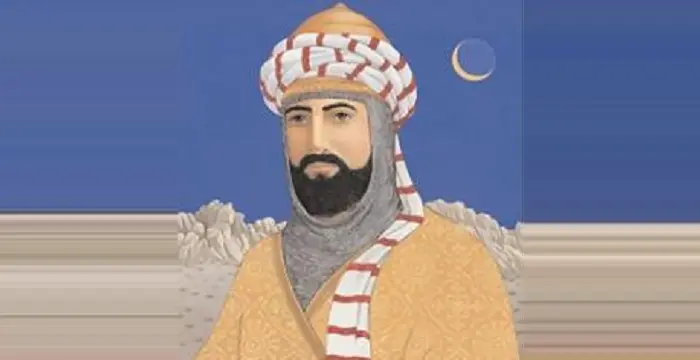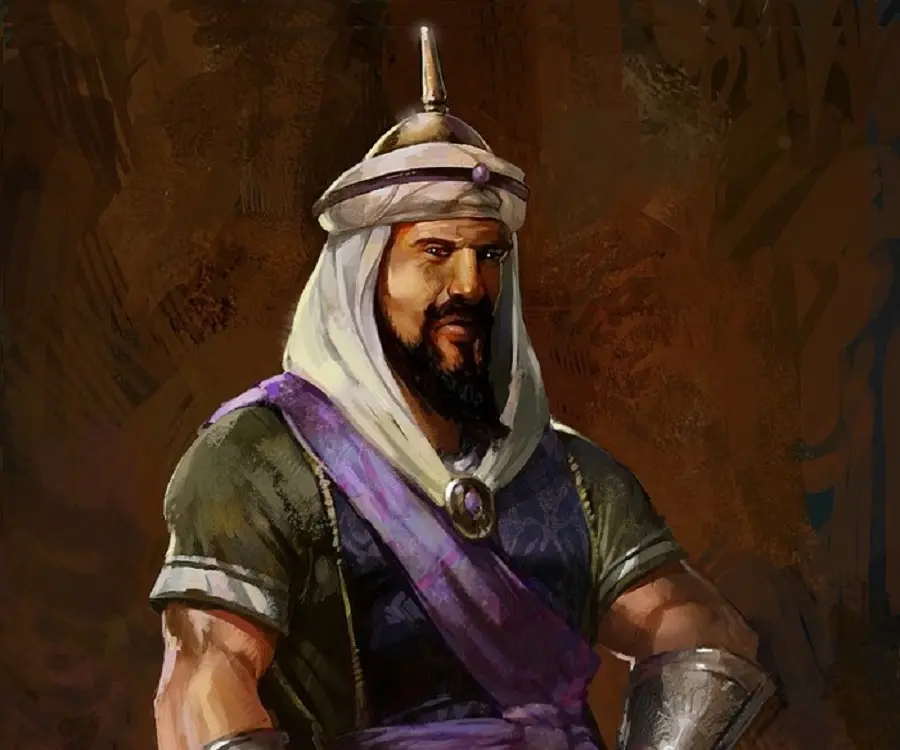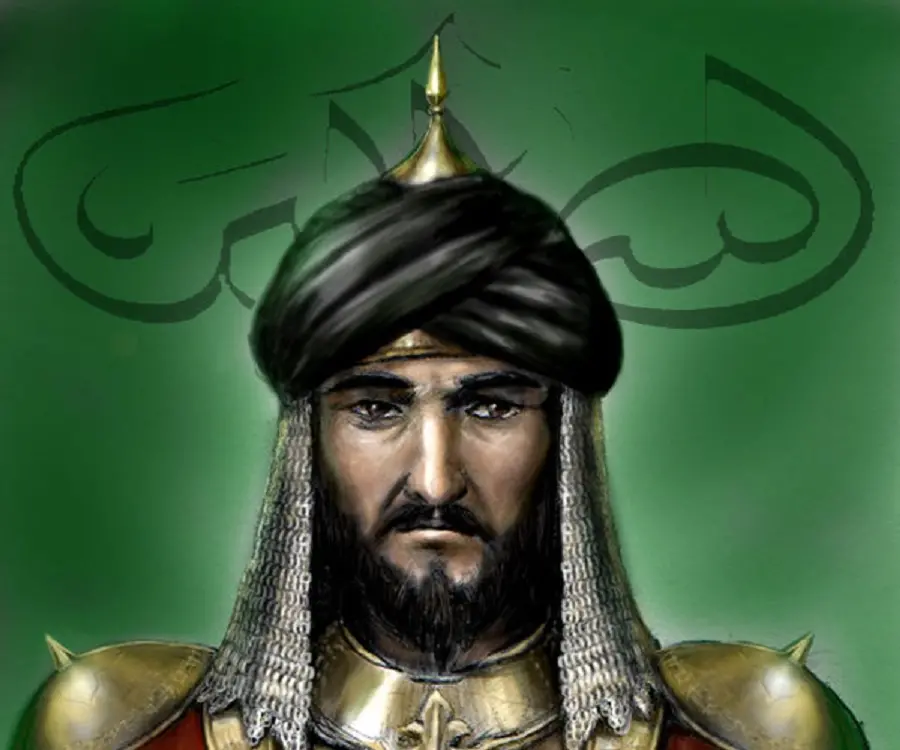
Saladin - Emperors, Family and Facts
Saladin's Personal Details
Saladin is the first ruler and founder of the ‘Ayyubid Dynasty’, and the famous Sultan of Egypt
| Information | Detail |
|---|---|
| Birthday | 1137 |
| Died on | March 4, 1193 |
| Nationality | Egyptian |
| Famous | Historical Personalities, Emperors & Kings, Leaders, Emperors, Kings, Sultan of Egypt |
| Spouses | Ismat ad-Din Khatun, Shamsa |
| Siblings | Al-Adil I, Turan-Shah |
| Known as | An-Nasir Salah ad-Din Yusuf ibn Ayyub |
| Childrens | Al-Afdal ibn Salah ad-Din, Al-Aziz Uthman, Al-Zahir Ghazi, Ishaq ibn Ṣalāḥ al-Dīn |
| Founder / Co-Founder |
|
| Birth Place | Tikrit, Iraq |
| Religion | Islam, Sunni Islam |
| Gender | Male |
| Father | Najm ad-Din Ayyub |
| Born in | Tikrit, Iraq |
| Famous as | Sultan of Egypt |
| Died at Age | 56 |
// Famous Kings
Sundiata Keita
Sundiata Keita was the founder of the Mali Empire in West Africa. This biography profiles his childhood, early life, struggles, founding of empire, rule, administration, achievements and also gives some fun facts.
Ashoka
Ashoka was the third emperor of the Mauryan Dynasty and ruled almost the entire Indian subcontinent. This biography profiles his childhood, life, reign, achievements and timeline
Murad IV
Murad IV was one of the mighty Sultans in the history of the Ottoman Empire. This biography profiles his childhood, family, accession, rule, administration and timeline.
Saladin's photo
Who is Saladin?
Saladin, famous Sultan of Egypt, and founder of the ‘Ayyubid Dynasty’, began his military career with a minor role, assisting his uncle Shirkuh. However, soon he proved his ability, and was given charge of more important battles. After Shirkuh's death, he took over as the vizier of the ‘Fatimid Caliphate’ and waged several wars in this capacity, gradually increasing his power in the Caliphate. He was in particular, effective against the English Crusaders, defeating them in almost every war fought. He reached the height of his power when al-Adid, Caliph of the ‘Fatimid Dynasty’ died, and this shrewd leader formed an alliance with rival ‘Abbasids’. Also, when his mentor, Nur ad-Din died, he went on to conquer the whole of Syria, attacking each city one by one. His major victory came against King Richard the Lionheart during the 'Battle of Hatin', when Palestine once again became a part of a Muslim dynasty, after eighty-eight years. When he died, he left all his possessions to the poor citizens of his dynasty, leaving nothing behind to give him a decent burial. Even after his death he is held in high regard, not just in Muslim countries, but also by countries in the west, where people remember him for his generosity and kindness
// Famous Emperors
Sundiata Keita
Sundiata Keita was the founder of the Mali Empire in West Africa. This biography profiles his childhood, early life, struggles, founding of empire, rule, administration, achievements and also gives some fun facts.
Ashoka
Ashoka was the third emperor of the Mauryan Dynasty and ruled almost the entire Indian subcontinent. This biography profiles his childhood, life, reign, achievements and timeline
Murad IV
Murad IV was one of the mighty Sultans in the history of the Ottoman Empire. This biography profiles his childhood, family, accession, rule, administration and timeline.
Childhood & Early Life
Saladin was born Ṣalāḥ ad-Dīn Yūsuf ibn Ayyūb, to Najm ad-Din Ayyub and his wife, in the year 1138, at Tikrit, Iraq. The following year, the family travelled to the city of Mosul, and was given shelter by the ruler Imad ad-Din Zengi.
Saladin later grew up in Damascus, Syria, and is known to have had a vast knowledge of philosophy, religion, science and mathematics. He also knew a lot about Arabs, their history, culture, heritage, and Arabian horses. Apart from that, he was well-versed in poetry, especially ones written by Arab poet Abu Tammam.
When Imad ad-Din Zengi died, his son, Nur ad-Din took over the throne, and Saladin's uncle, Asad al-Din Shirkuh served as a commander of the ‘Zengid’ army. It was under uncle Shirkuh's supervision, that the young boy learnt military tactics and strategies.
Shawar, the vizier of the ‘Fatimid Caliphate’ approached Nur ad-Din to help him in his struggle against rival leader Dirgham. Nur ad-Din obliged, and sent an army led by Shirkuh, to assist Shawar in the fight. Shirkuh and Shawar were accompanied by Saladin, but the latter did not have much of a role to play in the minor battle.
In 1164, the ‘Zengid Dynasty’ waged a war against the Crusader-Egyptian army that had attacked and captured the city of Bilbais. The army of the ‘Zengids’ were partly led by Shirkuh, while the other two sections were led by Saladin, and the Kurds, respectively.
In this war, the young general played a significant role by defeating Hugh of Caesarea, the leader of the rival army.
Accession & Reign
Soon, Shawar, the vizier of the ‘Fatimid Caliphate’, faced former ally Shirkuh in a war to gain control over Egypt. Shawar was assassinated in 1169, by Shirkuh's men, and the latter died soon thereafter, leaving Nur ad-Din in a dilemma about who would succeed his trusted general.
Though Nur ad-Din had chosen someone else, the Caliph, al-Adid decided that Saladin was to be his vizier. This choice was quite unusual, since the Caliphate was ruled by Shia Muslims, and the new vizier was a Sunni.
By 1170, the young vizier had consolidated his power over most of Egypt, with support from Nur ad-Din, and the Caliph of the ‘Abbasid Dynasty’, al-Mustanjid. One of his major battles during this time was the war waged against the King of Jerusalem, Amalric, in a bid to capture the cities of Darum and Gaza.
When al-Adid died in 1171, it was Saladin who took over as ruler of the ‘Fatimid Dynasty’, and the latter formed an association with the ‘Abbasid Caliphate’.
In 1173, the ruler of Aswan requested the new leader's assistance to ward off invaders from Nubia. Saladin obliged, and provided the former, troops led by Turan-Shah. The same year, his father, Ayyub succumbed to an injury resulting from a fall from his horse.
The following year, Nur ad-Din died of poisoning, and Saladin's troops seized Syria and Yemen, consolidating the hold of the leader's ‘Ayyubid Dynasty’.
By 1175, the ruler had captured the cities of Homs and Hama, which resulted in other ‘Zengid’ chiefs waging wars against him. Once the ‘Zengids’ were vanquished, al-Mustadi, the caliph of the ‘Abbasid Dynasty’ declared the former as the "Sultan of Egypt and Syria".
As the new Sultan, Saladin conquered several other areas, including the Upper Mesopotamian area known as Jazira. In 1177, he came back to Egypt, to look after royal matters there. The same year, with an army of 26,000 warriors, he launched an attack on Palestine.
King Baldwin, leader of the Crusaders struck Golan Heights in April, 1179, but was easily defeated by the Ayubbid forces.
During 1182-84, he attacked the cities of Sinjar, Beisan, Beirut, as well as Kerak, capturing them easily with his forces, and moved on to seize Aleppo. With the conquest of Aleppo, the Sultan's hold over Syria was reinforced. His attack on ‘Zengid’-ruled Mosul was however difficult to pull off, because of the opponent's strong allies.
In 1186, Saladin had to stall his attempts of conquering Mosul when he became sick, and a peace agreement was signed between the ‘Ayyubids’ and the ‘Zengids’.
The following year, the ‘Ayyubids’ fought the 'Battle of Hattin' against the Crusaders. This historic battle waged in 1187 resulted in the victory of Saladin, eighty-eight years after the Crusaders had captured Palestine from Muslim rulers.
In 1189, King Richard the Lionheart attempted for the third time, to conquer the Kingdom of Jerusalem, where they began with an attack on the Israeli city of Acre.
On September 7, 1191, the army of King Richard and that of the ‘Ayyubid Dynasty’ faced each other at the 'Battle of Arsuf'. The latter were forced to flee, since their army was weaker than that of the Crusaders. The ‘Ayyubids’ however, retaliated the next day, thwarting every attempt made by King Richard to recapture Jerusalem.
Major Works
Saladin is credited with the founding of the ‘Ayyubid Dynasty’, named after his father. The dynasty, under their Sultan’s leadership, was successful in conquering and uniting Syria, and recapturing Palestine, after it was held by the Crusaders for eighty-eight years.
Personal Life & Legacy
Saldin had more than one wife, though it is Ismat ad-Din Khatun, who is remembered as his bride. Ismat was earlier married to Nur ad-Din, but after the ‘Zengid’ ruler's death in 1174, she got married to the ‘Ayyubid’ leader.
The ‘Ayyubid’ ruler had several sons, of whom, the most famous are, al-Afdal, Az-Zahir Ghazi, Uthman, Mas'ud, and Yaq'ub.
On March 4, 1193, the great ruler of the ‘Ayyubids’ succumbed to a fever, in Damascus, Syria. Known for his generosity, he had distributed his wealth amongst the poor, and now lies buried outside the 'Umayyad Mosque'.
A province in Iraq is named Salah ad Din Governorate, after the great Sultan of Egypt. Kudistan's city of Arbil, houses the 'Salahaddin University', and a community called 'Masif Salahaddin', both named as a tribute to this ruler.
The coat of arms of Egypt is known as the 'Eagle of Saladin', and it represents the unity between Arab states.
Trivia
Even though Richard the Lionheart, and the Sultan of Egypt were enemies who had never met each other, both held each other in high regard. As the story goes, the latter even sent King Richard a spare horse when he lost his in the battle they were waging against each other.
Saladin biography timelines
- // 1138Saladin was born Ṣalāḥ ad-Dīn Yūsuf ibn Ayyūb, to Najm ad-Din Ayyub and his wife, in the year 1138, at Tikrit, Iraq. The following year, the family travelled to the city of Mosul, and was given shelter by the ruler Imad ad-Din Zengi.
- // 1164In 1164, the ‘Zengid Dynasty’ waged a war against the Crusader-Egyptian army that had attacked and captured the city of Bilbais. The army of the ‘Zengids’ were partly led by Shirkuh, while the other two sections were led by Saladin, and the Kurds, respectively.
- // 1169Soon, Shawar, the vizier of the ‘Fatimid Caliphate’, faced former ally Shirkuh in a war to gain control over Egypt. Shawar was assassinated in 1169, by Shirkuh's men, and the latter died soon thereafter, leaving Nur ad-Din in a dilemma about who would succeed his trusted general.
- // 1170By 1170, the young vizier had consolidated his power over most of Egypt, with support from Nur ad-Din, and the Caliph of the ‘Abbasid Dynasty’, al-Mustanjid. One of his major battles during this time was the war waged against the King of Jerusalem, Amalric, in a bid to capture the cities of Darum and Gaza.
- // 1171When al-Adid died in 1171, it was Saladin who took over as ruler of the ‘Fatimid Dynasty’, and the latter formed an association with the ‘Abbasid Caliphate’.
- // 1173In 1173, the ruler of Aswan requested the new leader's assistance to ward off invaders from Nubia. Saladin obliged, and provided the former, troops led by Turan-Shah. The same year, his father, Ayyub succumbed to an injury resulting from a fall from his horse.
- // 1174Saldin had more than one wife, though it is Ismat ad-Din Khatun, who is remembered as his bride. Ismat was earlier married to Nur ad-Din, but after the ‘Zengid’ ruler's death in 1174, she got married to the ‘Ayyubid’ leader.
- // 1175By 1175, the ruler had captured the cities of Homs and Hama, which resulted in other ‘Zengid’ chiefs waging wars against him. Once the ‘Zengids’ were vanquished, al-Mustadi, the caliph of the ‘Abbasid Dynasty’ declared the former as the "Sultan of Egypt and Syria".
- // 1177As the new Sultan, Saladin conquered several other areas, including the Upper Mesopotamian area known as Jazira. In 1177, he came back to Egypt, to look after royal matters there. The same year, with an army of 26,000 warriors, he launched an attack on Palestine.
- // 1179King Baldwin, leader of the Crusaders struck Golan Heights in April, 1179, but was easily defeated by the Ayubbid forces.
- // 1182 To 1184During 1182-84, he attacked the cities of Sinjar, Beisan, Beirut, as well as Kerak, capturing them easily with his forces, and moved on to seize Aleppo. With the conquest of Aleppo, the Sultan's hold over Syria was reinforced. His attack on ‘Zengid’-ruled Mosul was however difficult to pull off, because of the opponent's strong allies.
- // 1186In 1186, Saladin had to stall his attempts of conquering Mosul when he became sick, and a peace agreement was signed between the ‘Ayyubids’ and the ‘Zengids’.
- // 1187The following year, the ‘Ayyubids’ fought the 'Battle of Hattin' against the Crusaders. This historic battle waged in 1187 resulted in the victory of Saladin, eighty-eight years after the Crusaders had captured Palestine from Muslim rulers.
- // 1189In 1189, King Richard the Lionheart attempted for the third time, to conquer the Kingdom of Jerusalem, where they began with an attack on the Israeli city of Acre.
- // 7th Sep 1191On September 7, 1191, the army of King Richard and that of the ‘Ayyubid Dynasty’ faced each other at the 'Battle of Arsuf'. The latter were forced to flee, since their army was weaker than that of the Crusaders. The ‘Ayyubids’ however, retaliated the next day, thwarting every attempt made by King Richard to recapture Jerusalem.
- // 4th Mar 1193On March 4, 1193, the great ruler of the ‘Ayyubids’ succumbed to a fever, in Damascus, Syria. Known for his generosity, he had distributed his wealth amongst the poor, and now lies buried outside the 'Umayyad Mosque'.
// Famous Leaders
Edi Rama
Edi Rama is the current Prime Minister of Albania. Check out this biography to know about his childhood, life, achievements, works & timeline.
Tecumseh
Tecumseh was a Native American leader of the Shawnee clan. This biography profiles his childhood, life and timeline.
Khalifa bin Zayed Al Nahyan
Sheikh Khalifa bin Zayed Al Nahyan is the current President of the United Arab Emirates (UAE). Check out this biography to know about his birthday, childhood, family life, achievements and fun facts about him.
Anwar Sadat
Anwar Sadat was the third President of Egypt and has been awarded the Nobel Prize for his peace initiatives. To know more about his childhood, career, profile and timeline read on the following biography.
Leo Varadkar
Cam Leo Varadkar is the current Taoiseach—the Prime Minister—of the Republic of Ireland. Check out this biography to know about his childhood, family life, achievements and other facts about his life.
Swami Vivekananda
Swami Vivekananda was the chief disciple of Sri Ramakrishna, and was responsible for awakening India spiritually. Check this biography to know in detail about his life, profile and timeline.
Saladin's FAQ
When was Saladin died?
Saladin was died at 1193-03-04
Where was Saladin died?
Saladin was died in Damascus
Which age was Saladin died?
Saladin was died at age 56
Where is Saladin's birth place?
Saladin was born in Tikrit, Iraq
What is Saladin nationalities?
Saladin's nationalities is Egyptian
Who is Saladin spouses?
Saladin's spouses is Ismat ad-Din Khatun, Shamsa
Who is Saladin siblings?
Saladin's siblings is Al-Adil I, Turan-Shah
Who is Saladin childrens?
Saladin's childrens is Al-Afdal ibn Salah ad-Din, Al-Aziz Uthman, Al-Zahir Ghazi, Ishaq ibn Ṣalāḥ al-Dīn
Which company or organization was founded by Saladin?
Saladin was the founder/co-founder of The Ayyubid dynasty
What is Saladin's religion?
Saladin's religion is Islam, Sunni Islam
Who is Saladin's father?
Saladin's father is Najm ad-Din Ayyub
How famous is Saladin?
Saladin is famouse as Sultan of Egypt










